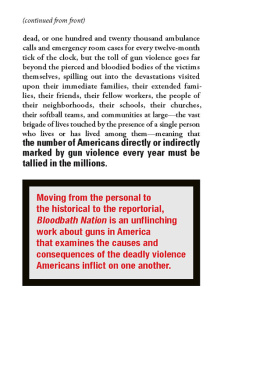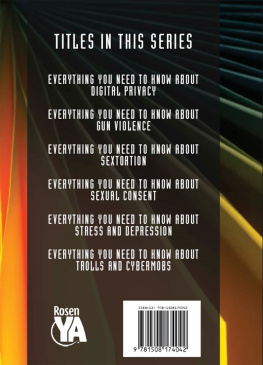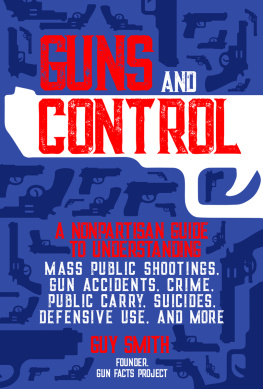THE GUN DEBATE
WHAT EVERYONE NEEDS TO KNOW

Oxford University Press is a department of the University of Oxford. It furthers the Universitys objective of excellence in research, scholarship, and education by publishing worldwide. Oxford is a registered trade mark of Oxford University Press in the UK and certain other countries.
What Everyone Needs to Know is a registered trademark of
Oxford University Press
Published in the United States of America by Oxford University Press
198 Madison Avenue, New York, NY 10016, United States of America.
Oxford University Press 2020
All rights reserved. No part of this publication may be reproduced, stored in a retrieval system, or transmitted, in any form or by any means, without the prior permission in writing of Oxford University Press, or as expressly permitted by law, by license, or under terms agreed with the appropriate reproduction rights organization. Inquiries concerning reproduction outside the scope of the above should be sent to the Rights Department, Oxford University Press, at the address above.
You must not circulate this work in any other form and you must impose this same condition on any acquirer.
CIP data is on file at the Library of Congress
Names: Cook, Philip J., 1946 author. | Goss, Kristin A., 1965
Title: The gun debate : what everyone needs to know /
Philip J. Cook, Kristin A. Goss.
Description: 2nd edition. | New York : Oxford University Press, 2020. |
Series: What everyone needs to know |
Revised edition of the authors The gun debate, [2014] |
Includes bibliographical references and index.
Identifiers: LCCN 2019035359 (print) | LCCN 2019035360 (ebook) |
ISBN 9780190073466 (hardback) | ISBN 9780190073459 (paperback) | ISBN 9780190073473 (updf) | ISBN 9780190073480 (epub)
Subjects: LCSH: Gun controlUnited States. | Firearms ownership
United States. | FirearmsLaw and legislationUnited States.
Classification: LCC HV7436 .C657 2020 (print) | LCC HV7436 (ebook) |
DDC 363.330973dc23
LC record available at https://lccn.loc.gov/2019035359
LC ebook record available at https://lccn.loc.gov/2019035360
Contents
We are indebted to a number of experts whose research and advice we sought in writing and rewriting this book. Despite our combined 75 years of experience studying gun violence and gun policy, we needed and greatly appreciated the help. We are also deeply grateful for the extraordinary research assistance provided by Julia Quinn for the first edition of the book, as well as Olivia Levine, Akanksha Ray, and Curtis Scarpignato for the second edition.
THE GUN DEBATE
WHAT EVERYONE NEEDS TO KNOW
A more precise term for the subject of this book is firearm, which is a portable weapon that shoots projectiles from a metal tube, propelled at high speed by expanding gas that is generated by the explosion of gunpowder in a confined space. So, we will not be discussing water pistols or BB guns or pricing guns, or for that matter cannons or catapults or rocket launchers. The focus is on the weapons owned by households for hunting, target shooting, and self-defense and by police and private security officers as tools of their trade. There are many types of firearms, the most common of which can be categorized as rifles, shotguns, pistols, or revolvers.
Like so many commodities, firearms serve a variety of useful purposes but are also subject to misuse. The misuse, whether accidental or intentional, accounts for 40,000 deaths per year in the United States
Probably the greatest concern is in conjunction with interpersonal violencehomicide, assault, and robbery. When the perpetrator uses a gun rather than a knife or club or bare fists, the likelihood that the victim will die is greatly increased. The And because guns can be used to kill quickly, with little effort and from a distance, they give individuals who are so inclined the capacity to terrorize neighborhoods, assassinate even well-guarded public officials, and perpetrate one-man rampages in schools, workplaces, houses of worship, and other public places.
Although firearms can cause great harm, they also have value in recreation (hunting, target shooting, collecting) and as tools for self-defense and police work. Guns are similar to other consumer products and services in having both positive and negative uses. Motor vehicles are involved in crashes that kill about the same number of Americans each year as guns. Prescription painkillers are associated with 17,000 overdose deaths a year in the United States alone.
For vehicles, drugs, medical care, and many other products, including firearms, it is reasonable to ask, How can we reduce the problems of misuse while preserving the benefit of normal prudent use? For inspiration, we note that the highway-safety problem has been greatly reduced over the decades while preserving the value of highway travel. Thanks to better roads, safer vehicles, seatbelt requirements, and anti-drunk-driving enforcement (among other things), the highway fatality rate has been cut in half since 1950 (even though vehicle miles per capita have increased by a factor of three). For firearms, too, we can aspire to reduce misuse while preserving value.
Among the wealthy nations of the world, the United States has the highest prevalence of private gun ownership. Even in the
While the prevalence of households with guns is of interest, it is important to remember that guns usually are personal possessions, not household appliances with shared ownership. National surveys differ somewhat on the percentage of adults who own guns. Three reputable surveys conducted in 2014, 2015, and 2017 produced estimates for adult ownership of 24%, In many other respects, such as types of guns owned and reasons for gun ownership, these surveys are more consistent.
How many guns are in private hands altogether? Since guns are not registered in most jurisdictions, we have to rely on estimates rather than counts. If we take 25% as the best estimate of individual ownership for 2018, there were about 63 million adult owners in the United States. If we knew the average number of guns per owner or household, wed be able to estimate the total household firearms inventory. But it is hard to elicit that information in a survey, and few surveys have attempted to do so. One exception is the 2015 National Firearms Survey, which asked respondents not just whether they had a gun in the home, but how many. Extrapolating from the results leads to an estimate of about 265 million firearms in private hands. Sales data make clear that tens of millions of guns have been added since then. For 2018, we estimate that there are about 300 million guns in private hands, or almost 5 per individual owner.
Besides surveys, another approach to estimating the total is to use federal records on firearms commerce. It is possible to add up all the firearms that have been manufactured in the United States, add the imports, and subtract the exports. Applying this approach to data from 1899 to 2016 (and excluding sales to the military), the estimated total would be 344 million firearms as of 2016.firearms still exist today. If we assume that just 1% of the stock has been scrapped each year since 1945, and apply this assumption to the federal records, then the current total would be reduced to 259 million guns in 2016.












